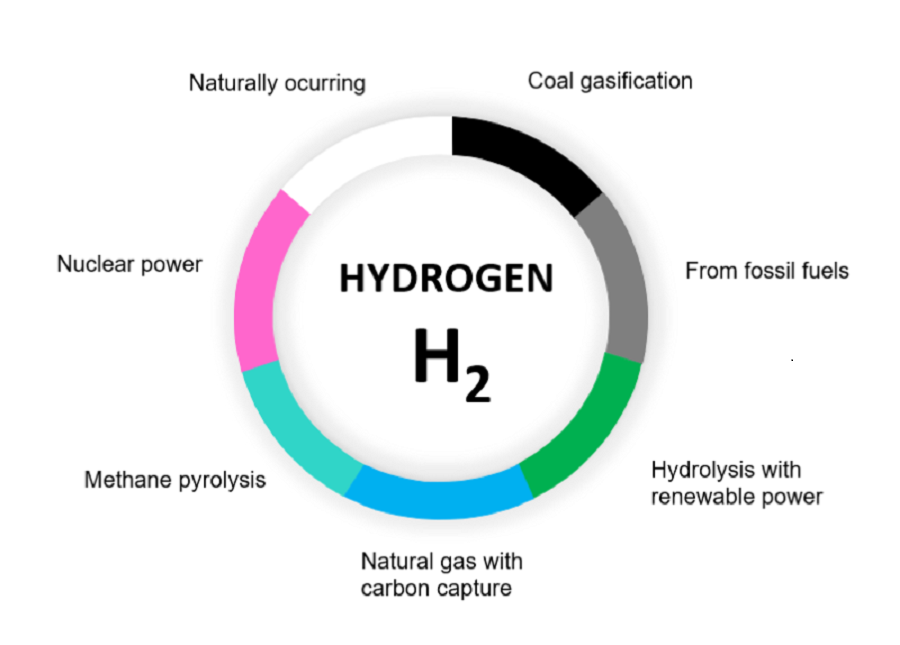Unveiling the colours of a clean energy future
The key to a future of cleaner, more sustainable energy comes from hydrogen, the most plentiful element in the universe. It has been used in many different industries and has fuelled space exploration, including the historic moon landing. Nowadays, the oil-refining and synthetic nitrogen fertilizer sectors consume the majority of the 73 million metric tons of pure hydrogen produced each year. On the other hand, as the globe becomes more decarbonized, hydrogen is seen as an essential energy source. Investigating the hydrogen spectrum, which is distinguished by colours signifying various sources and production processes, is crucial to comprehending its potential. An overview of the production, expenses, and important players related to the many colours of hydrogen is given in this blog.
Colours of Hydrogen
Black or Brown Hydrogen – A Coal-Based Source: It is derived from coal gasification, and brown hydrogen, from lignite coal, are produced through the conversion of solid coal into a gaseous form, which includes methane gas. The coal reacts with oxygen and steam under high temperatures and pressure, resulting in syngas (hydrogen, carbon dioxide, and carbon monoxide).
Grey Hydrogen – Fossil Fuel-Based Hydrogen: It is produced from fossil fuels, primarily using gas reforming. This process converts natural gas and steam into hydrogen and carbon dioxide. It is often criticized for its substantial carbon emissions.
Green Hydrogen – The Clean, Renewable Option: It is produced through the electrolysis of water using renewable energy sources like solar or wind power. This technique is eco-friendly because it produces no carbon emissions.
Blue hydrogen, also known as low-carbon natural gas-based hydrogen, is mostly made from natural gas through the use of techniques like steam methane reforming. The process can be rendered carbon-neutral by capturing and storing the carbon dioxide generated underground.
Turquoise Hydrogen: A Link Between Green and Blue: Unlike blue hydrogen, turquoise hydrogen is created by a different process. A low carbon intensity process is provided by a pyrolyzer, which splits natural gas feedstock to produce hydrogen and solid carbon.
Pink Hydrogen: Nuclear-Powered Hydrogen: Using nuclear energy as a power source, water is electrolyzed to produce pink hydrogen, sometimes referred to as purple or red hydrogen.
Within the next ten years, it is hoped to reduce the cost of producing hydrogen by nuclear power to $1/kg.
White hydrogen is a naturally occurring resource that can be found in geysers, volcanic gas, hydrothermal systems, and the oceanic and continental crust of the Earth. The origin is still being investigated.
Production Cost and Challenges
Hydrogen, often known as black or brown, is created from coal, an unclean and non-sustainable fossil fuel. By 2030, the market is predicted to reach $48.9 billion, although environmental concerns and the growing expense of carbon capture and storage (CCS) technology cast doubt on the industry’s viability. The Grey kind of hydrogen is the most widely produced form of the gas nowadays and is made from a range of fossil fuels. However, it also has a high carbon footprint. The transition to cleaner hydrogen sources poses a challenge to the future of grey hydrogen.
The promising hydrogen type, i.e., Green hydrogen, which is produced using renewable energy sources and is the cleanest form of hydrogen. Its demand is expected to grow significantly in the future, as it is a key enabler for the transition to a clean energy economy. Like the same type, blue hydrogen is produced from natural gas with CCS technologies. It is a lower-carbon option than grey hydrogen, but its cleanliness depends on the effectiveness of CCS technologies. Blue hydrogen could play a role in the transition to a clean energy future, but its viability depends on the development and deployment of CCS technologies at a commercial scale.
In the emerging technology of production, Turquoise hydrogen is a new one that produces hydrogen from natural gas without using CCS. It is still in the early stages of development, but it has the potential to offer a more sustainable and cost-effective alternative to blue hydrogen.
The main challenge of Pink hydrogen, which is produced using nuclear power, is the production of radioactive waste even though it is a low-carbon option. It is not yet commercially available, and there are some concerns about the safety and environmental impact of nuclear hydrogen production. A hypothetical type of hydrogen production, white hydrogen, would be a carbon-free energy source, but it is not yet clear whether it can be produced at a commercial scale. Overall, green hydrogen is the most promising type of hydrogen for the future due to its low to zero carbon emissions and growing demand from sustainable energy sectors. [4]
The industrial player in Hydrogen Production
- Companies like Shell, Total Energies, and Equinor are replacing grey hydrogen with cleaner production methods.
- Green hydrogen Key players include Bloom Energy Corp., Plug Power, and Next Hydrogen Solutions. Major oil and gas companies like Shell and BP are also investing in green hydrogen.
- Industrial gas supplier Air Products plans to invest heavily in blue hydrogen production.
- Companies like Mitsubishi Heavy Industries Group have invested in turquoise hydrogen production.
- Projects like PNW Hydrogen and EDF aim to produce pink hydrogen using nuclear energy.
- White hydrogen resources are the subject of projects in Australia, Mali, and the United States. [5]
Conclusion
Finally, there is a wide range of innovation and sustainability in the hydrogen realm. Every colour stands for a distinct step toward a future with cleaner, more sustainable energy. The world is trying to switch to greener energy sources and lessen its carbon footprint, thus it’s important to know the many colours of hydrogen. As a result of growing investment and technological progress, hydrogen has the potential to be a key component of the ambitious decarbonisation agenda. Looking ahead, we see this as an evolution of the hydrogen rainbow leading to a more sustainable and brighter future, not just a shift to cleaner energy.
Sources
- https://www.nationalgrid.com/stories/energy-explained/hydrogen-colour-spectrum
- https://www.nytimes.com/interactive/2023/08/12/climate/clean-energy-us-fossil-fuels.html
- https://www.bitsathy.ac.in/proficient-catalyst-for-green-hydrogen/

